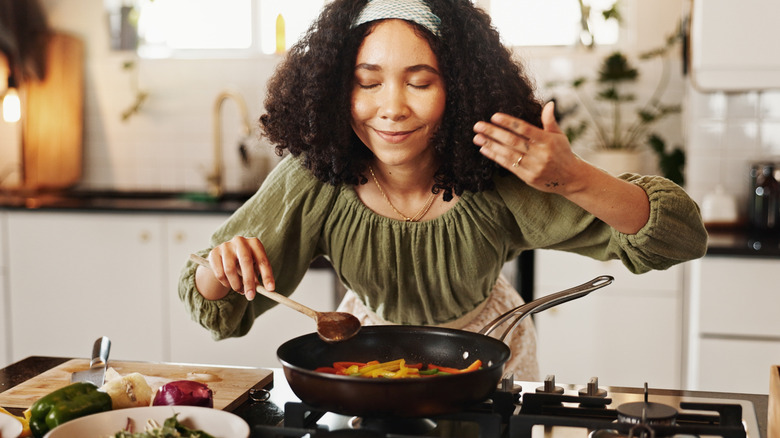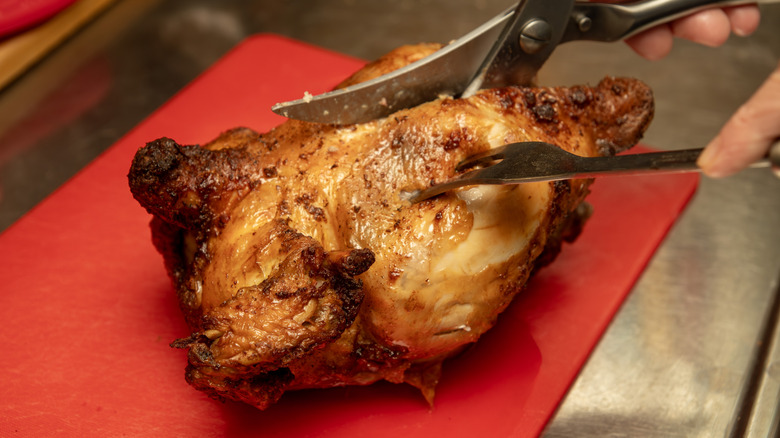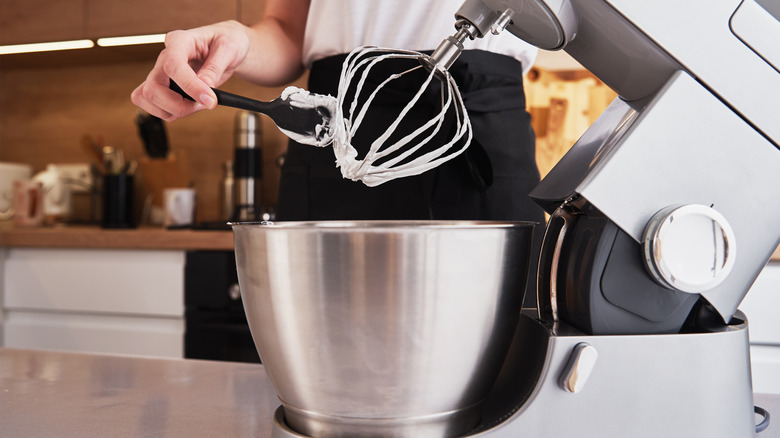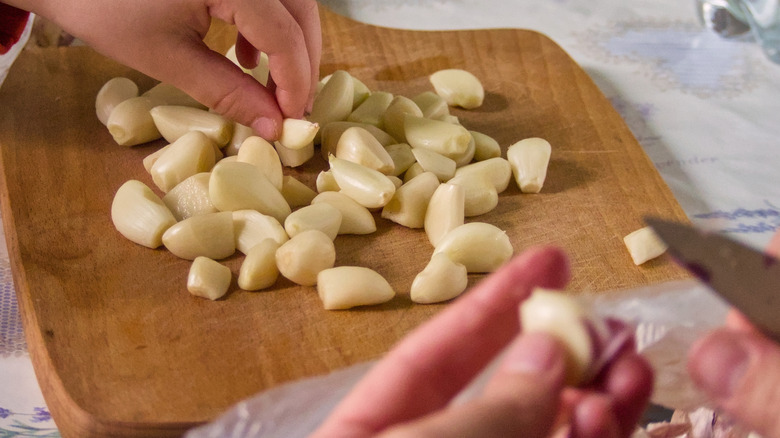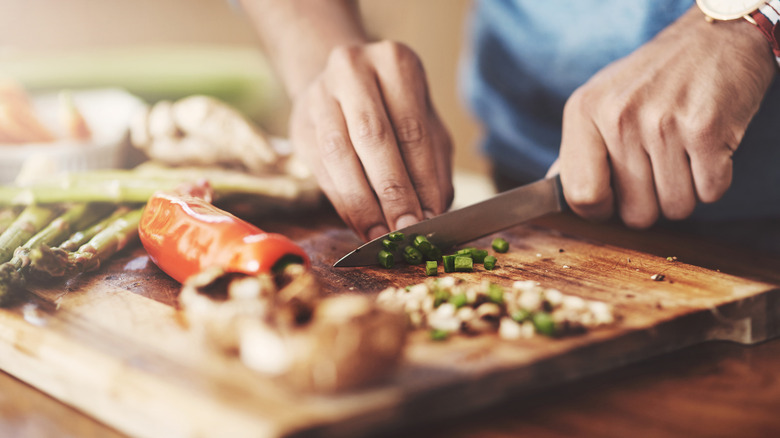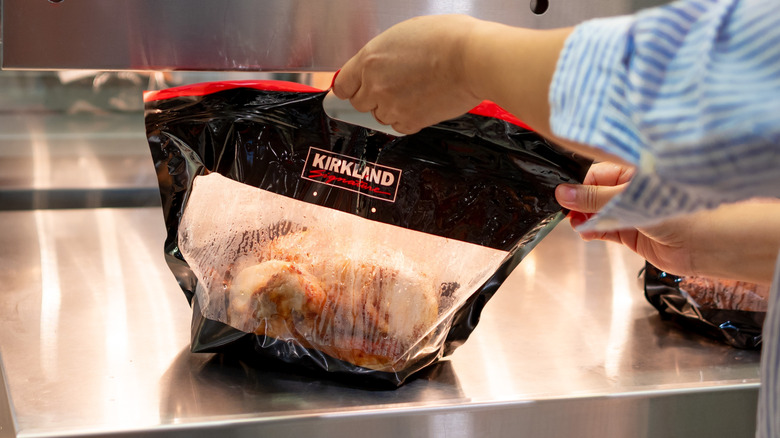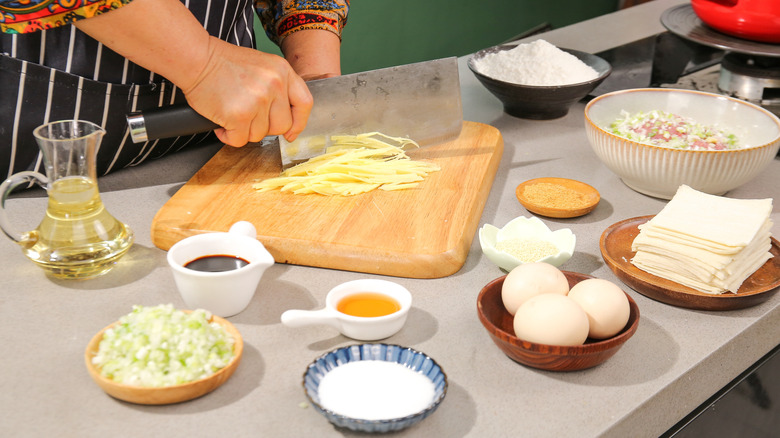Time-Saving Kitchen Hacks Every Home Cook Needs To Know
We may receive a commission on purchases made from links.
Those of us who spend long periods in the kitchen know that whipping up a quick meal isn't always an easy feat. Dicing veggies, measuring ingredients, making sure the pot doesn't overflow; it all takes time, and good food can't be rushed — or can it? Interestingly enough, there are ways to make cooking an easier process, and as a result, more time-effective, too.
In this article, we're detailing some of the most practical ways to reduce the amount of time spent in the kitchen in an effort to help you streamline your typical cooking process. From interesting gadgets to consistent and purposeful planning, we're confident you'll find at least one new way to approach the kitchen that will radically change the way you prepare meals. Sound interesting? If so, stick around. We're gathering the best time-saving kitchen tips and tricks to help you shave minutes off your culinary clock.
Follow cooking formulas rather than specific recipes
Do you often find yourself whipping out your phone in search of great recipes for nearly every meal? Stop. Though it's certainly helpful to have a few good recipes up your sleeve, it's far better to invest your hours learning the process of cooking rather than attempting to hunt down the perfect recipe.
You see, searching for recipes takes time — not only this, but stopping to ensure that measurements, oven temperatures, and cooking times are correct can disrupt your workflow. A better approach is to train your brain to think in terms of culinary formulas. For example, a combination of butter and flour can do wonders for thickening soups, stews, sauces, and gravies, while an air fryer can be used to make mean roasted chicken thighs every single time.
Another example of using formulas in the kitchen is knowing which flavors pair well together and which are bound to clash. Tomato and basil are always a winning duo, though beef broth poured over chicken probably isn't going to yield the flavor you intended. Drawing a blank? Pop on your favorite cooking show. Don't just watch casually; pay attention to what the chef does and why they do it. This can help expand your skills and increase your confidence the next time you're in the kitchen.
Consider kitchen shears over knives to quickly cut meat
We know; we know. Most chefs on Reddit (and in real life) will tell you that learning how to use a knife properly is the ultimate claim to fame in the kitchen. And while we aren't here to contest that, what we will say is that the use of kitchen shears is totally underrated, especially when it comes to daunting tasks like cutting raw meat.
Look, we all know that wielding a shiny butcher knife over a pretty wooden cutting board tends to look pretty legit, but for home cooks juggling toddlers, house chores, and a variety of other responsibilities, practicality usually wins over technicality. That's why we love tools like this KitchenAid Kitchen Shears — simply cut through meat like you would a piece of paper for even, beautiful meat slices. These work for cooked and uncooked meats, though you should obviously never use the same shears for both without washing.
Don't be afraid to make use of kitchen gadgets
Along with kitchen shears, other gadgets can also work to make cooking faster and easier. Got a big family? Invest in a long griddle like this DASH Deluxe Everyday Electric Griddle to whip up pancakes and sausage all at once. Like smoothies but don't feel like hauling out your clunky blender? Buy an Amazon Basics Multi-Speed Immersion Hand Blender or any handheld immersion blender to help you quickly puree or blend drinks, soups, and sauces. A food processor is also nifty, from chopping veggies to grating cheese, this common kitchen tool serves a variety of purposes that can assist you in getting dinner on the table ASAP.
With that said, we understand that not every kitchen gadget is worth the counter space, and thus, we recommend thinking carefully about your needs before investing in certain tools. An avid baker, for example, might consider an expensive stand mixer essential, while another home cook who doesn't bake often might only need the appliance once or twice a year. The moral of the story? It's OK to invest in gadgets that will actually help you in the kitchen — just be sure to buy them because you need them, not because they're trendy.
Cut butter into small cubes to help it soften faster
Softened butter is useful when making cookie dough or slathering over freshly baked bread, but if you're anything like us, you probably don't always have sticks of it sitting at room temperature. Rather than waiting 30 minutes to an hour for it to soften, it's better to cut the butter into cubes. Doing so causes the butter to soften more quickly than leaving it in one large chunk, meaning less wait time.
Exactly how long will it take for butter to soften using this method? It's hard to say; since every kitchen temperature is different, butter will soften at different rates. What we can say is that it won't take long -– if a full stick (usually) takes a little under an hour, it's reasonable to think butter would achieve the desired softness within 15 minutes when cubed. Cool, huh?
Always put canned and frozen fruits and veggies to use when you can
No, canned and frozen fruits and veggies don't quite taste the same as fresh, but putting them to use in certain dishes just makes sense. Whether you're dishing up a quick stew or planning to bake a casserole, using frozen or canned veggies can shave minutes off the clock, meaning supper can make it to the table faster. The same goes for frozen fruits. Use frozen cherries in pies, frozen bananas to make smoothies, or frozen strawberries to make a tantalizing, summer berry syrup.
When using canned or frozen fruits and veggies, take their water content into account. Draining canned carrots before dumping them in a casserole or thawing peaches before making them a part of a cobbler is crucial to avoiding a watery result. Be sure also to take the flavor of canned and frozen fruits and vegetables into consideration. You might not notice the lack of freshness in meals like soups and stews. On the other hand, stir-fried dishes or certain desserts might taste slightly different when using canned or frozen ingredients over fresh.
Peel loads of garlic and store for later
If you're a lover of fresh garlic, you're likely familiar with the many ills associated with peeling each clove. Thankfully, there are a couple of ways to get the job done quickly, allowing you to store plenty of freshly peeled garlic for later use. The easiest way to peel garlic is to shake it; simply place the cloves in a metal bowl, invert another bowl on top, shake, and release. The other is to soak the garlic in water overnight – this bulk garlic peeling method used by restaurants is one that still requires you to peel the cloves, only this time, the skins should fall away easily.
Once you've peeled your garlic, it's time for storage. Place the cloves in a resealable bag to be kept in the refrigerator or freezer for later use. Need your garlic minced? Try running it through that food processor we mentioned earlier to get the job done in record time.
Quickly chop eggs used for salads using this hack
Need to dice boiled eggs in a jiffy? Try a cooling rack. Because the shape and texture of boiled eggs can sometimes make them difficult to chop, a cooling rack like this Spring Chef 10 x 15 Inch Stainless Steel Cooling Rack works to accomplish much the same thing without dirtying a knife.
To use a cooling rack to chop eggs, set it on a flat surface, place a plate or cutting board underneath, and slide deshelled, boiled eggs through the grid. And there you have it ... neatly diced eggs. It goes without saying that you'll want to make sure the cooling rack is clean — you don't want old crumbs or debris caught in the food. As for what to use these freshly chopped eggs for, well, that's totally up to you. Egg salad, potato salad, chef salad — the world is your oyster. Yes, it's unconventional to chop eggs with a cooling rack, but it's one hack we couldn't keep to ourselves.
Always microwave citrus fruits before juicing
If you need fresh citrus juice, try using your microwave to get the most out of the fruit. Though most juice enthusiasts recommend rolling citrus across the counter to get a higher juice yield, we find that a microwave amps up the effectiveness of this rolling technique all the more. To use a microwave to extract more juice from your oranges, lemons, limes, and other citrus fruits, try nuking them for about 20 seconds (more or less, depending on their size and quantity). Then, firmly roll them back and forth across the counter, pressing down as you roll.
The result? More juice than you'd imagine. The heat from the microwave works to soften the fibers in the citrus, thereby producing more juice than if you had not tried this approach. Utilizing this method not only saves you time but also money. Instead of purchasing a full-blown juicer, a manual juicer, such as this affordable OXO Good Grips 2-in-1 Citrus Juicer, could prove to be the only tool you need to meet your juicing needs. Sweet!
Prep everything (way) ahead of time
As most of us know, preparing for holidays and other big occasions typically requires preparation way ahead of time. However, something you may not know is that you can approach your weekly menu in a similar fashion. All you really need to know is exactly what you plan to cook and on what day. This is where weekly meal planning comes in handy. Yes, it takes time to plan meals for daily consumption, but when compared to the amount of time saved, it's worth the extra effort.
Once you know what you're going to eat and when, prepare the items you know you'll need upfront — dice your veggies (using a food processor, of course), cook rice and divide it into portions, boil eggs, etc. After most foods are prepared, store everything in the fridge for use in the upcoming week. This straightforward, game-changing move ensures you have what you need already prepped beforehand, making meal preparation throughout the week as easy as dump-and-go.
Fix marinades, sauces, or dressings the night before
While we're on the subject of prepping ahead of time, did we mention the same concept applies to marinades, sauces, and dressings? You may be able to make these at the beginning of the week, along with everything else. However, if the sauce, marinade, or dressing contains ingredients that might perish before the week's end, it might make more sense to prepare it the night before you use it.
To pull it off, make your sauce, marinade, or dressing recipes and store them in airtight containers in the fridge. As the ingredients in these homemade concoctions begin to mingle, you'll notice their flavors getting stronger — and more delicious. For marinades, you can even opt to add your meat to the mix — just be sure to keep an eye on it and never marinate for longer than 24 hours. Also, remember that not all meats will be able to withstand longer marinating times. Options like fish may disintegrate when exposed to acidic elements like vinegar and lemon juice for long periods, so keeping the marination short (15 to 30 minutes) is usually your best bet.
Batch cook and freeze your recipes for later use
We can admit that batch cooking probably sounds like more pain than it's worth, but we promise, you'll be happy you did it in the end. At its core, batch cooking can be defined as cooking your food in full "batches," rather than individual mealtime portions. This means that instead of cooking enough taco meat for only one dinner, you'd double the recipe and cook enough for two, or maybe even three dinners. Now, every time you're ready to eat tacos, you'll have the meat — just open the freezer, warm it up, and plop it on tortillas with toppings.
Batch cooking is also very flexible, meaning you can choose how much or little you want to cook in advance. Rather than cooking the meat for one future meal, consider doubling the recipe before devouring one and freezing the other. We've done this several times with options like lasagna and meatloaf, though virtually any meal that freezes well would make a good candidate. Ultimately, how you go about batch cooking is completely up to you. Do what works, and watch the dinnertime scramble become a thing of the past.
Take advantage of store-bought rotisserie chicken
A store-bought rotisserie chicken usually costs no more than $5 to $6, yet lends itself to endless possibilities. Using the meat from a rotisserie chicken to create quick and easy weeknight meals on busy evenings is one of the best ways to put your hard-earned dollars to use. Simply pull the meat off the bone while it's still warm, shred, and place it in an airtight container for later use. Once you're ready, feel free to use the meat in virtually any recipe that calls for chicken: quesadillas, soups, stir-fry, or even easy lunch sandwiches.
Not quite ready to use the chicken right away? No worries. If you don't plan to use all the chicken at once, place the shredded meat in a resealable freezer bag and store it in your freezer for later use. You can't beat the price, and honestly, not having to cook the chicken is the best part of all. Oh, and don't forget to hang onto that rotisserie chicken carcass! You can boil it in water with a few carrots, onions, and seasonings to make delicious and nutritious stock. See this homemade chicken stock that separates great cooks from the good. Yum!
Mise en place
Mise en place (me-zohn-plahs) is a French term that translates to "everything in its place" in English. In the culinary world, it means getting everything you'll need to cook ready, measured ingredients, and all. But it doesn't stop there. You'll also want to whip out the correct cookware and tools, and don't forget to read the recipe all the way through before you begin. All of this is done in an effort to make the process of cooking more seamless. With everything organized, pulling a meal together suddenly becomes a much easier, quicker, and rewarding task.
You should feel free to take the mise en place concept to whatever extent you want. While you could certainly place all of your measured ingredients in fancy white ramekins like the pros do on cooking shows, it isn't always necessary. The goal here is to streamline your kitchen strategy; preparation is key, but to what extent you take it is totally up to you.

